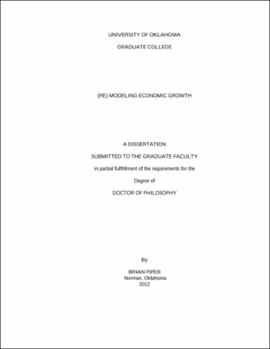| dc.contributor.advisor | Grier, Kevin | |
| dc.creator | Piper, Brian D. | |
| dc.date.accessioned | 2019-06-07T01:03:24Z | |
| dc.date.available | 2019-06-07T01:03:24Z | |
| dc.date.issued | 2012 | |
| dc.identifier | 991792502042 | |
| dc.identifier.uri | https://hdl.handle.net/11244/320328 | |
| dc.description.abstract | Chapter 1: Economists examine two types of variables when studying aggregate production and economic growth. Factors which appear in standard Solow-type models (physical capital, labor, and human capital) are classified as direct inputs to production. Variables which affect aggregate output, but are not independently productive, are classified as indirect inputs. I introduce a flexible framework which allows indirect inputs to affect output through three channels: by altering total factor productivity, by changing factor-specific productivity (FSP), and by changing the incentive to accumulate direct inputs. An empirical application of the model to infrastructure, worker health, and childhood nutrition finds that indirect inputs have strong effects on the productivity of specific direct inputs. Non-nested hypothesis tests conclude that an FSP model is preferable to a model which includes the same indirect inputs in TFP. Higher levels and growth rates of indirect inputs are also shown to incentivize increased factor accumulation of direct inputs. Finally, these extensions produce more empirically realistic predictions for returns to scale and convergence than traditional neo-classical models. | |
| dc.description.abstract | Chapter 2: I extend the limited literature on international spatial economic growth by employing a clear procedure for model selection and highlighting the importance of using time fixed effects that are region specific. Using a sample of countries in the continental Americas, I find that after capturing shocks to the region with fixed effects, estimates of spatial effects are negative and significant, in contrast to most of the existing literature. The net economic value of these spatial effects is of a magnitude similar to the value of the initial growth, and failing to account for growth spillovers is shown to bias estimates of the effectiveness of growth altering policies. | |
| dc.description.abstract | Chapter 3: I study a sample of quarterly and/or monthly data from 8 countries to address the question of how deficit uncertainty affects output growth. Uncertainty is measured using the conditional heteroskedasticity of the respective series. These measures are then incorporated in a VAR GARCH-M model. Results show that while deficit uncertainty does have a significant, negative effect on output growth in the US, this result does not hold universally. Evidence suggests that the effect may be unique to more developed countries. The magnitudes of uncertainty effects are demonstrated with a simulated one-time shock to the deficit and with a permanent shock to the overall level of deficit uncertainty. | |
| dc.format.extent | 111 pages | |
| dc.format.medium | application.pdf | |
| dc.language | en_US | |
| dc.relation.requires | Adobe Acrobat Reader | |
| dc.subject | Economic development | |
| dc.subject | Factors of production | |
| dc.subject | Economic development--Mathematical models | |
| dc.title | (Re)Modeling Economic Growth | |
| dc.type | text | |
| dc.type | document | |
| dc.thesis.degree | Ph.D. | |
| ou.group | College of Arts and Sciences::Department of Economics | |
